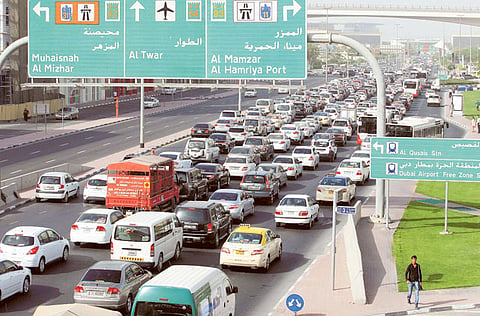Salik dodgers causing traffic tailbacks on Dubai and Sharjah roads
Motorists in Al Ghusais and adjoining neighbourhoods fuming at road disruption

Dubai: A steep increase in traffic on alternative routes between Dubai and Sharjah since the introduction of two new Salik gates on Al Ittihad Road and Airport Tunnel has left residents in Al Ghusais, Al Nahda, Al Twar and Oud Al Muteena fuming.
They say that the usually smooth traffic movement in the area has been severely disrupted as roads in Dubai areas adjoining Sharjah, particularly Al Ghusais, are clogged by motorists trying to avoid the Salik toll.
The Salik toll gates on Al Ittihad Road and Airport Tunnel became active on April 15, charging motorists Dh4 for passing through the gate.
The Roads and Transport Authority (RTA) introduced the toll gates in an attempt to reduce traffic on the perennially clogged Al Ittihad Road that serves as the main link between Dubai and Sharjah. The RTA officials were not available for comment despite repeated requests.
Although there has been a positive difference in traffic movement on both Al Ittihad Road and Airport Tunnel, it has come at the expense of other parallels streets such as Beirut Street, Damascus Street and Doha Street, which have seen a steep increase in traffic.
“Life is not the same any more for us on Damascus Street. I have never experienced this much traffic before in this area,” said Selva Rajan, who has been a resident of Al Ghusais for the past ten years.
"I used to arrive home from my office, which is located in Deira, within 20 minutes, but now it takes 30 minutes just to navigate through traffic on Damascus Street."
Traffic during peak hours in the morning as well as in the evening is even worse on Al Ittihad Road, while improving considerably during non-peak hours.
“New Salik gates have completely altered traffic movement between Dubai and Sharjah, people were forced to change their usual movement plans. But the sad thing is Al Ittihad Road continues to remain clogged during rush hours as most people prefer to pay Salik because the alternatives are much worse,” said Syed Hassan, a resident of Al Nahda in Sharjah and a regular commuter between the two emirates.
Salik’s impact has reached as far as Ajman, as Shaikh Mohammad Bin Zayed Road, the preferred and most convenient choice for people living in Ajman and working in Dubai, is worst hit.
“What used to be a 90-minute journey before now takes more than two hours as traffic moves at a snail’s pace and with roadworks taking place on Shaikh Mohammad Bin Zayed road, driving is a curse, but there is no alternative,” said Naushad Abbasi, who lives in Ajman and works in Media City.
However, it’s not all grim with many motorists claiming “Salik has made life easier”,
“I don’t mind paying Dh4 as far as it is smooth sailing and I’m happy traffic movement has become smoother after 10am in the morning when I go to work,” said Abdul Wahid who, like a few others, said movement during non-peak hours has been positively impacted by Salik.
"Earlier Al Ittihad Road used to be chock-a-block even until noon in the direction of Dubai but that has changed since the introduction of Salik and even on the way back there is not much traffic after 8pm.
"Before Salik was introduced it used to be clogged until 11pm."
Salik, which means clear or open in Arabic, is a road toll system which was introduced by the RTA in 2007.
Including the Al Ittihad Road and Airport Tunnel gates, there are six toll gates currently in operation in Dubai.
The other gates are on Garhoud Bridge, Al Maktoum Bridge and there are two on Shaikh Zayed Road near the Mall of the Emirates and Safa Park.
Sign up for the Daily Briefing
Get the latest news and updates straight to your inbox



